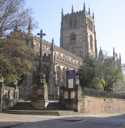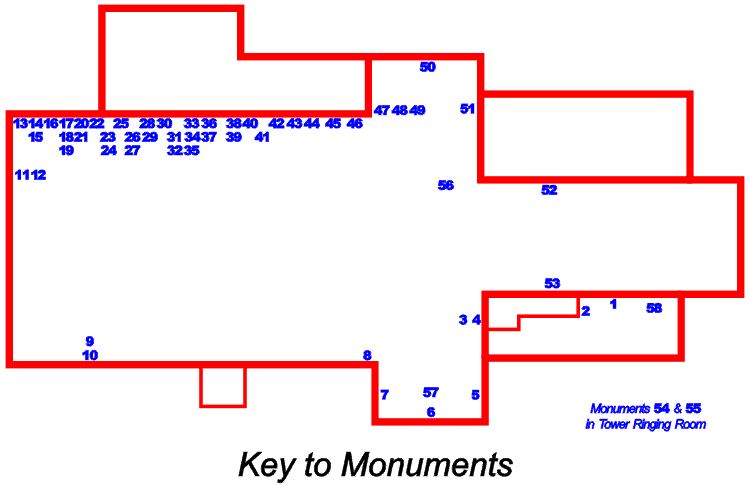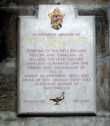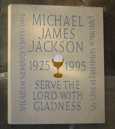For this church:    |
|
| IN THANKFUL MEMORY OF NEVILLE STUART TALBOT MC DD SOMETIME OF THE RIFLE BRIGADE FELLOW AND CHAPLAIN OF BALLIOL COLLEGE OXFORD CHAPLAIN IN FRANCE 1914-1918 FRIEND AND COUNSELLOR OF TOC H BISHOP OF PRETORIA 1920-1933 VICAR OF THIS CHURCH 1933-1943 ASSISTANT BISHOP OF THIS DIOCESE AUGUST 21ST 1879 APRIL 3RD 1943 |
This monument is also listed as a War Memorial.
2Michael Jackson
A plaque of modern design, dedicated to Canon Michael Jackson, reading in the middle:
Vertically to the left is:
VICAR OF ST MARY’S 1973-1991
and to the right:
CANON OF SOUTHWELL 1973-95
In the middle, between the two dates, is a symbol of the Eucharist.
Entrance to Lady Chapel
3Bernard McCraith
See the Interior War Memorials page for details of this plaque.
4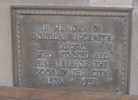 Douglas
McCraith
Douglas
McCraith
IN MEMORY OF |
South Transept
5The Earls of Clare
Transcribed from the Latin as follows:
John Hollies of Houghton, Golden Knight was elevated to be Baron Houghton and Earl of Clare by King James. He reared five sons and three daughters of great distinction. He died on the 4th day of October in the year of Our Lord 1637.
Also his son, the most noble John, Earl of Clare. He was father to two sons and thirteen daughters of great distinction. He died on the 2nd of January in the year of Our Lord 1665. This monument was erected in place of another much mutilated one, removed [In cætuum aretatorum commodum – the text is corrupt] in April in the year of Our Lord 1804.
There is a drawing of the original tomb, dated 1637. It was described as a massive structure with an urn and obelisks and included a “vast display of titles and family.
 Monument
to the Monument
to theEarls of Clare |
The family lived, when in Nottingham, at the old Thurland Hall, which when they owned it was known as Clare Hall.
The original 1637 tomb was of John Holles, First Earl of Clare (1564-1637) who served in the Battle of the Armada, and his son John Holles, the second Earl, MP for Retford (1595-1666).
In 1804 the tomb was described as on the south and east wall and ‘in a very broken and mutilated state’. A faculty was granted to remove it and replace it with the present ‘handsome tablet of marble with an inscription thereon to agree with the said tombstone’. The space created by the removal of the monument was used to erect seat stalls and pews for the use of parishioners ‘who may be destitute and in want of seats’, to help meet the need created by the great increase of people living within the parish.
In 1804 the tomb was removed and the coats of arms with an abridged inscription placed on the wall. The inscription on the old tomb is recorded by Deering.
6The Samon tomb
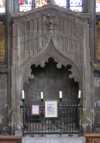 The
Samon tomb The
Samon tomb |
The canopied tomb on the south wall of the south transept, has nothing now to identify the family name. In 1800 the walls were whitewashed, destroying the identifying shield and gilded letter ‘S’ which appeared there. The effigy of a man in long robes lies on the floor beneath the canopy. The figure is damaged but wears the long, buttoned, high-collared, loose sleeved gown of a merchant. His shoes are pointed and he carries a long civic sword, hanging from the right shoulder by a decorated strap. He has short hair and beard, high hat with a flat top and upturned sides, the whole outfit suggesting a man living in the reign of Henry IV or Richard II.
The head of the family was John Samon, four times Mayor, who died in the first quarter of the 15th century and is recorded as the benefactor of the church. In the past a window above the Samon tomb bore the words ‘Orate pro anima Johannis Samon et Agnetis uxoris ejus’ (Pray for the soul of John Samon and Agnes his wife) Agnes was the daughter of John de Tannesley, part of whose tomb is seen opposite in the north transept. Recent research looking at masons’ marks in the church showed that the Samon tomb was built at the same time as the church.
7 Alexander
Manson
Alexander
Manson
| SACRED TO THE MEMORY OF ALEXANDER MANSON ESQ. M.D. F.R.S. WHO DEPARTED THIS LIFE AT DARLEY DALE IN THE COUNTY OF DERBY, IN THE CHURCH OF WHICH PARISH HIS REMAINS ARE INTERRED, THE 19TH DAY OF MARCH 1840 IN THE 67TH YEAR OF HIS AGE. HE HAD SERVED FOR THIRTEEN YEARS IN THE ROYAL NAVY ON BOARD H.M.S. PHOENIX, SUPERB, SOPHIE, AMETHYST AND PENELOPE AND AT THE CAPTURE OF MARTINIQUE. SUBSEQUENTLY, FOR THIRTY YEARS WITH EMINENT SUCCESS HE PRACTICED AS A PHYSICIAN IN THIS TOWN, AND, IN HIS PROFESSIONAL CAPACITY, CONTRIBUTED TO RAISE THE HIGH MEDICAL REPUTATION TO WHICH THOSE NOBLE CHARITIES, THE GENERAL HOSPITAL AND THE LUNATIC ASYLUM HAVE ATTAINED. IN PUBLIC LIFE HE WAS ALIKE DISTINGUISHED FOR ZEAL, INTREPIDITY & PHILANTHROPY; IN SOCIAL LIFE, BY UNIFORM KINDNESS OF HEART, AND UNOSTENTATIOUS PIETY. HIS NUMEROUS FRIENDS, TO EVINCE THEIR SENSE OF HIS WORTH, AND THEIR ESTIMATION OF HIS CHARACTER, HAVE UNITED TO ERECT AND DEDICATE THIS MONUMENT TO HIS MEMORY |
Alexander Manson was born in Scotland in 1774 and served in the Royal Navy for 13 years before coming to live in Nottingham in 1813. He worked in the then newly built General Hospital and was also employed at the St Mary’s Workhouse dispensary. He died in Darley Dale on 19th March 1840 at the age of 66.
South Aisle
8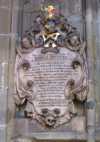 Thomas
Smith
Thomas
Smith
Near this place lieth the Body of who died Jan. 8th. A.D. 1727 Ætat 45  He was a Man of Exact  He married MARY ye Daughr. |
In 1658 Thomas Smith purchased for £210 the house and shop at the East end of South Parade, at the corner of Peck Lane. His business was that of a mercer, a dealer in any kind of goods or wares, and by his industry, enterprise and fair dealing he built up a reputation, and secured the confidence of both town and country people. At this time there were no banks in which to deposit money, and because of his integrity people began to bring him their spare money for safe keeping and he gave them promissory notes and allowed them interest. The business grew. Underneath the shop was a basement kitchen, beneath this he made in the solid sandstone rock three separate cellars, approached by a trap door and ladder, and another set below them approached by steps. It was here that he secured his money. He grew out of these premises and moved thirty yards to the present day bank at the top of Exchange Walk which is still known as Smiths Bank although it is now run by NatWest.
9The Children of Francis & Mary Warren
A rectangular brass plaque, in a stone frame, reading:
| TO THE MEMORY OF THE CHILDREN OF THE LATE FRANCIS JAMES WARREN FORMERLY CAPTAIN IN H.M. 9TH LANCERS AND MARY SHAW WARREN HIS WIFE ELIZABETH MARY BORN AT NOTTINGHAM 8TH DEC. 1818 DIED AT TORQUAY 26 JAN. 1841 FRANCIS HARDWICK LIEU. 5TH REGT. BENGAL NATIVE INFANTRY BORN AT NOTTINGHAM 20TH OCTOBER 1820 KILLED IN ACTION ON THE 13TH JAN. 1842 DURING THE RETREAT OF THE BRITISH ARMY FROM CABUL CAROLINE BORN AT NOTTINGHAM 26 JULY 1823 DIED AT LEAMINGTON 30 MARCH 1853 They that dwell in the land of the shadow of Death upon them hath the light shined. ISAIAH chap·ix·v·xi IN AFFECTIONATE REMEMBRANCE OF THEM BY THEIR MOTHER 1865 |
This monument is also listed as a War Memorial.
10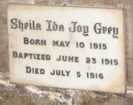 Sheila
Grey
Sheila
Grey
A small plaque, immediately below the Warren family memorial, reading simply:
| Sheila Ida Joy Grey Born May 10 1915 Bbaptised June 23 1915 Died July 5 1916 |
West End
11Thomas Walker
IN “Be ye also ready.” |
12Catherine Padley
| SACRED TO THE MEMORY OF CATHERINE PADLEY WHO DEPARTED THIS LIFE THE IX DAY OF NOVR. MDCCCXXIX IN THE XXVI YEAR OF HER AGE. SHE WAS THE BELOVED WIFE OF ROBERT WILKINSON PADLEY ESQR. OF BULCOTE LODGE IN THIS COUNTY AND ONLY DAUGHTER OF THOMAS ROBERTS OF THIS TOWN GENTLEMAN AND OF SARAH HIS WIFE. |
North Aisle
There are a large number of monuments on the north wall of the church.
13John Whitt with other family members
A simple oval monument which reads:
Within this Porch Also the Bodies of THOMAS MORRIS, Likewise the Bodies of JOHN ALLEYNE |
14John & Catherine Morris
In the same Place lies interred the Body of Also of CATHERINE MORRIS The memory of the Just is blessed. |
15Ann Hollings & Mary Hay
Near this Place Rest gentle shade and wait the Maker, wife. Also, the remains of MARY HAY Wife of They were both Daughters of |
16 Robert & Mary Wright and family
A memorial stone in two sections. The text reads:
Near this Place Also three Sons and six Daughters Also MARY, Wife of the above |
Also EDMUND WRIGHT And FRANCES WRIGHT |
17Ichabod & Elizabeth Wright
ICHABOD WRIGHT Esqr. ELIZABETH his Wife Providence indulged them |
18The Children of Ichabod & Elizabeth Wright
Sacred And of  also of his two Sisters, And  Mark the perfect Man, and behold the upright |
19Mary Wright
On a lead memorial, practically at ground level:
HERE LYES INTERRD YE BODY THE ELDEST DAUGHTER OF Mr THO.WRIGHT  FARWELL [SIC], GREAT SOUL, THAT FROM YE WORLD RETIRED, |
The name of Mary Wright is encircled by the words:
SIC TRANSIT GLORIA MUNDI
20Lawrence Whittaker
As a due TRIBUTE  He early pursued his Studies in Divinity,  He possessed many Virtues,  Vivit post Funera Virtus. |
21Samuel & Ann Tupman
This Monument Also to the Memory of Their Remains are interred |
22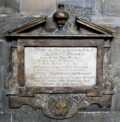 Samuel
Wright & Thomas Wright
Samuel
Wright & Thomas Wright
Near this Place is interr’d the Body of  Also the Remains of his Father THOMAS WRIGHT |
23Thomas & Elizabeth Hall
| BENEATH THIS STONE ARE DEPOSITED THE REMAINS OF THOMAS HALL, ESQ. OF THIS TOWN BORN MAY XIII. MDCCXLIII. DIED OCT. I. MDCCCXXXV. ALSO THOSE OF ELIZABETH HIS WIFE WHO DIED APRIL XXVIII. MDCCCXIV. AGED LXXIV YEARS. |
24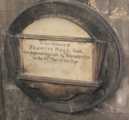 Francis
Hall
Francis
Hall
| To the memory of FRANCIS HALL, Gent. Who departed this Life 14th. February 1801; in the 85th. Year of his Age |
25Sarah Roberts
| SACRED TO THE MEMORY OF SARAH ROBERTS, WIDOW OF THOMAS ROBERTS, LATE OF THIS TOWN, GENTLEMAN, WHO DIED VTH. JULY MDCCCLI, AGED LXXIV YEARS. |
26John Bradshaw
| SACRED TO THE MEMORY OF JOHN BRADSHAW, SECOND SON OF JOHN BRADSHAW, ESQR. LATE OF STRETTON, IN THE COUNTY OF CHESTER: WHO DEPARTED THIS LIFE ON THE 7TH. DAY OF SEPTEMBER 1822, AGED 67 YEARS. |
27Robert & Sophia Saxton
| SACRED TO THE MEMORY OF ROBERT HORATIO SAXTON, LATE OF THIS TOWN, WHO DIED 1ST. AUGUST 1847, AGED 41 YEARS. ALSO OF SOPHIA, WIDOW OF THE ABOVE AND RELICT OF ROBERT JAMES SYKES, LATE OF THIS TOWN, SOLICITOR, WHO DIED 28TH. OCTOBER 1895, AGED 79 YEARS. |
28Grace Bradshaw
| SACRED TO THE MEMORY OF GRACE BRADSHAW, THE WIFE OF JOHN BRADSHAW, WHO DEPARTED THIS LIFE JAN.Y 3RD. 1831, AGED 70 YEARS. |
29Marianne Skipwith, Mary Skipwith, John George Skipwith
SACRED AGED 21 YEARS. |
30Damaged effigy
Throsby’s edition of Thoroton produced a drawing of an alabaster figure of a man in medieval costume, on an elaborately carved table tomb. The figure had his hands together in prayer. He said that ‘beside the north wall to the west of the Church is a much damaged figure’. The damaged figure now on the floor west of the entrance to the choir vestry that would seem to be the same one. Deering says:
In [the north transept] is an alabaster tomb, on which lies the figure of a man in a gown, with wide sleeves and a cap on his head, the hands in a praying posture, it has no inscription; in the side which faces the south are four figures in basso relievo, the 1st and 3rd counting from the left to the right hand, are angels holding each an empty escutcheon before them, the second is a mitred figure, and the 4th seems to be in a sitting posture, having a coronet on the head.
Various theories have been proposed for the identity of the effigy; that it represents Robert English, a wealthy Nottingham merchant who lived at Weekday Cross and who died in 1475; also that it belonged to the tomb of John Alestre, a Burgess in 1415 and 1425, who died in 1431 and was buried in the north transept.
31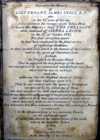 James
Still
James
Still
| Sacred to the Memory of LIEUTENANT JAMES STILL; R.N. who in the 22nd. year of his age, fell a victim to the ravages of the Yellow Fever, on Board His Majesty’s Ship, THE PHEASANT, while stationed off SIERRA LEONE, on the 12th. of October 1821. For four successive years he had been employed in the fatal service of enforcing obedience to that sacred Law, which, to the honour of his Country and in the spirit of Christian Love forbade the Traffick in Human Blood. That he possessed the best feelings of the heart was manifested in his unwearied watchfulness over those whose aid he was in sickness, and who, withering like the blighted shoots of Spring, left their blessings upon him: That he was endued with the spirit of Enterprise was proved by the testimony of those who had witnessed his skill, and admired his gallantry: That he was characterized by suavity of temper and prepossessing manners was apparent from that regard, excited in every breast, which held him forth as an Ornament of Social Life. How beloved a Son! How endeared a Brother! How esteemed a friend is evidenced in the poignant grief of his sorrowing Family, in the unfeigned regret of many who cherish the remembrance of his worth, and in the heartfelt Tribute of Him who dedicates this tablet to the Memory of his Virtues. |
32 Thomas
Newdegate
Thomas
Newdegate
| Near this place Lies Interr’d the Body of THOMAS NEWDEGATE Esqr. Third Son of SR. RICHARD NEWDEGATE of Ardbury in the County of WARWICK Bart. Serjeant at LAW who Departed this Life the 24th. of January 1722 Aged 74. |
33Ann Haines
| Sacred to the Memory of Ann Haines, Relict of the late Revd. Nathan Haines, D.D. Vicar of this Parish; She died sincerely lamented by her Relations and Friends after enduring a long & severe Illness with true Christian Resignation, July 1st. 1811, in the 68th. Year of her Age. |
34Frederick John Cox
See also the monument to his younger brother, below.
TO THE MEMORY OF  Farewell dear Youth! Too soon thy course is sped |
35Frederick John Lissant Cox
This monument appears directly below that of the other Frederick John Cox. It appears that this boy was born just after his older brother’s death, and given (almost) the same name, and later died at a similar age.
ALSO TO THE MEMORY OF FREDERICK JOHN LISSANT COX,  Early they fell, two young and fairest Plants: |
36Thomas Berdmore
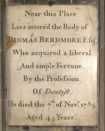
| Near this Place Lies interr’d the Body of THOMAS BERDMORE Esqr. Who acquired a liberal And ample Fortune By the Profession of Dentist; He died 7th. of Novr. 1785, Aged 45 Years. |
Thomas Berdmore and his family gave St Mary’s three vicars. The first was Samuel, Vicar from 1708 to 1723. Also was Samuel’s son, the Revd Scrope Berdmore, Vicar between 1743 and 1770. During Scrope Berdmore’s time a number of church bells were installed, inscribed with his name. Thomas the dentist, born 1740, son of the Revd Thomas Berdmore and his wife Martha appears to have joined the old and reputable [Royal] dental practice of Watts Rutter & Green in Racquet Court, off Fleet Street, before he was 21 and was 22 when he was passed at the Old Bailey as Surgeon’s Mate to the Regiment of Artillery. At only 26 he was appointed ‘Operator for the Teeth’ to King George III and at 28 he published a book about dentistry.
Thomas Berdmore never married, he was only 45 when he died and bequeathed large sums to his nieces. His whole estate amounted to £40,000, a huge fortune in 1785. His body was brought back to Nottingham in an elegantly decorated horse-drawn hearse to the White Lion Inn for a funeral procession to St Mary’s, where he was buried in the chancel alongside his Uncle Scrope.
37 Samuel
Heywood
Samuel
Heywood
| To the Memory of Mr. SAMUEL HEYWOOD, Attorney at Law of this Town; who died July 25th 1789, Aged 34. As a MAN, eminently respectable in his Day, & worthy to be remembered by Posterity. In his PROFESSION, intelligent, liberal, and uncorrupt. As a SON, a HUSBAND, & a BROTHER, his Duty, Gratitude, Love & Kindness could not be exceeded. His Sprightleness and Affability; the Ease, Urbanity, and Chearfulness of his Conversation; united with Firmness of Mind, with a vigorous & cultivated Understanding unwarped by Prejudice, undisturbed by Passion endeared him to SOCIETY. These Excellencies were heightened by the Principles of RELIGION, at once manly, rational & sincere. A few Friends, who deeply regret his Loss, testify their Affection, and soothe their Sorrow, by this Memorial of his VIRTUES |
38Nathan Haines
| Sacred to the Memory of NATHAN HAINES, D.D. Who was 35 Years Vicar of this Parish. Prebendary of Southwell, Rector of Cotgrave, and Perpetual Curate of Snenton, in this County. Perpetual Curate of Tong, in the County of York; and first Domestic Chaplain to the Right Honl. the Earl Manvers. He departed this Life highly respected, and sincerely lamented, April 27th. 1806 in the 71st. Year of his Age. |
39Sarah Tillard
| SACRED to the Memory of SARAH Relict of the Rev:d R: TILLARD: Late Vicar of WORKSWORTH in the County of DERBY. She possessed a sound Judgement: An understanding highly cultivated: A correct and refined Taste Her Piety was warm and unaffected. Her Death has deprived her Family of an affectionate Parent: And her Friends, of a chearful and instructive Companion. She departed this Life April 25:th 1810 After a short and painful Illness, In the 67:th Year of her Age. |
40Thomas Roberts
| SACRED TO THE MEMORY OF THOMAS ROBERTS, WHO DEPARTED THIS LIFE APRIL 1. 1825. AGED 52 YEARS. |
41 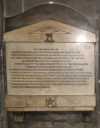 George
Coldham
George
Coldham
| TO THE MEMORY OF GEORGE COLDHAM LATE TOWN CLERK OF THIS PLACE WHO IN THE FORTY NINTH YEAR OF HIS AGE WAS KILLED BY THE OVERTURN OF A CARRIAGE ON THE 18TH OF SEPR 1815 AT BRIGHTON AND WAS THERE BURIED THIS TABLET WAS ERECTED BY VOTE OF THE MAYOR AND COMMON COUNCIL OF NOTTINGHAM IN ORDER"PUBLICLY TO EXPRESS THEIR HIGH SENSE OF THE "PROBITY, ABILITY AND SIGNAL ADVANTAGE TO THE CORPORATION "WITH WHICH FOR THE LAST TWENTY FOUR YEARS HE PERFORMED "THE SEVERAL FUNCTIONS OF HIS OFFICE AND THEIR WARMEST "COMMENDATION OF HIS MERITORIOUS EXERTIONS IN THE "PRESERVATION OF THE PEACE OF THIS POPULOUS TOWN DURING "THE LATE THREATNING PERIOD" |
Coldham was born in London but moved to Nottingham to join Richard Enfield’s law firm where he worked as a solicitor. When Enfield died of fever in 1791, he was succeeded by Coldham, his partner. Coldham nowadays is best known for writing to the Home Secretary about his fears concerning the Luddite riots. He was afraid that there were not enough troops to cope and that revolutionaries were using the riots as a front.
42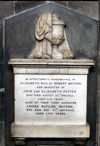 Elizabeth
Watson
Elizabeth
Watson
IN AFFECTIONATE REMEMBRANCE OF ALSO THEIR THIRD DAUGHTER |
43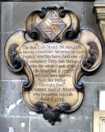 Lady
Mary Brabazon
Lady
Mary Brabazon
| The Honble. Lady MARY BRABAZON. a Devout and Constant Attender on Gods Publick Worship here; And one of Exemplary Piety and Vertue thro the Whole Course of her Life, Dyed Janry. 2d. 1737/8. And Lyes here Interr’d Near Her Father The Right Honble. CHAMBRE Earl of MEATH, who Departed this Life April 1st. 1715. |
44Thomas Wright and other family members
A memorial made up of four panels. The upper panel reads:
| THOMAS WRIGHT ESQR. DIED XX JULY MDCCXC, AGED LXV |
The three lower ones read:
| MARY NEVILL WRIGHT DAUGHTER OF THOMAS AND MARY WRIGHT DIED XXV NOV MDCCLXXXIV AGED XIX. |
| MARY WRIGHT WIDOW OF THOMAS WRIGHT ESQ. DIED XIX MAY MDCCCXVII AGED LXXIX. |
| ELIZABETH WRIGHT DAUGHTER OF THOMAS AND MARY WRIGHT DIED IV APRIL MDCCLXXXIX AGED XVI. |
45Sarah Watson
TO  “Her children called her blessed, and |
46Henry Burgass Lee
REMEMBER  HENRY BURGASS LEE, M.A.  CANON OF SOUTHWELL AND SOMETIME DURING FORTY EIGHT YEARS OF FAITHFUL  His knowledge and counsel were  PATER SEMPER OPTIMUS  1874 – 1951  Remember also his wife |
North Transept
47Charles Plumptre
A plaque very high up on the west wall of the transept. This is a translation from the Latin:
Here lie the remains of Charles Plumptre S.T.P. Archdeacon of Ely, He was the son of John, of Nottingham, Esquire, a man entirely most virtuous. Everlasting in memory most esteemed, most worthy in undying memory. Who forbade a monument to be erected to him. Each of the two dutifully cultivated accustomed virtue. The father with grief awaited death. The son did not fear So great has been the power of goodness and faith. The former was born in the year 1680, the latter in 1712. The former died in the year 1751; the latter in 1779. Safe in the One disposing power, or in the Natal, or the Mortal Hour.
48 William
Gibson
William
Gibson
Sacred  Their remains are deposited in a Vault at the Eastern
end of |
49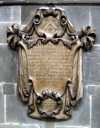 Henry
Plumptre
Henry
Plumptre
HERE lyes interrd  Animam Nati |
50Thomas Thurland, John de Tannesley, William de Amyas
 The
canopy tomb The
canopy tombin the north transept |
On the north wall of the north transept is a canopy tomb which was erected after the completion of the church and is now composed of elements from three medieval monuments. The canopy is attributed to Thomas Thurland, the Purbeck Marble slab to William de Amyas and the alabaster table to John Tannesley. A framed fragment of carved alabaster which came from the tomb chest of wealthy Nottingham merchant Robert English (died 1475) rests on this tomb. Robert English was mayor in 1470.
The Canopy is attributed to Thomas Thurland, who died in 1473/4. Thurland was the most important person in the town at the time, remembered for many years as the owner of Thurland Hall on what is now Thurland Street. He was mayor in 1449 and 1458, a benefactor of the Trinity Guild which had a chapel in this transept and was one of the aldermen of the Guild at the time of his death. His widow, Dame Joan Thurland, asked in her will to be buried in the church beside the sepulchre of her husband and left 26s 8d ‘to the works of St Mary’s.’
The alabaster tomb beneath the canopy is attributed to John de Tannesley, Bailiff of Nottingham in 1395, Mayor in 1399 and 1410 and who died 1413/14. The Tannesley family was related by marriage to the Samon family. De Tannesley’s will requests that he be buried in St Mary’s on the north side with four chaplains celebrating divine service for his soul in the Chapel of St John. His wife Alice asked to be buried in St Mary’s in the Chapel of John the Baptist on the north side of the church next to her husband. John de Tannesley was also an Alderman of the Trinity Guild. His tomb was probably situated originally on the west wall of the north transept where it is believed the altar of St John the Baptist was located, the tomb having on it an image of John the Baptist and the Trinity. The tomb is also remarkable as having a rare carving of a Lily Crucifix.
The tomb slab credited to William de Amyas would originally have born inlaid brass effigies of Amyas and his wife. It probably originated in the south transept, the location of the Amyas Chantry. It is suggested that it was transferred from the previous, Norman, church during rebuilding in the 15th century.
De Amyas was also known until 1327 as William de Mexborough. He settled in Nottingham, became a leading and successful merchant, dealing in corn and wool and owning four large ships. He married Margery Palmer, accumulated substantial property in and around Nottingham, later becoming a banker and money lender who dealt with the monks at Lenton Priory and Edward III. In 1316 at a time of devastating floods and severe famine he was licensed to journey to France and bring back grain for Nottinghamshire and Derbyshire. He was Mayor in 1316, 1324, 1328 and 1333.
In 1324 William de Amyas provided for a daily mass to be said for himself and his family. The chantry priests were Gervase and William de Holbeck who were granted an income of 5 marks and 16 pence and a house in High Pavement in which to live. The Archbishop of York confirmed that the daily mass should be said for the souls of William de Amyas and his family and that on Sundays and feast days a six pound wax candle was to burn on the Amyas tomb while mass was in progress
51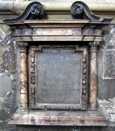 Henry
Plumptre
Henry
Plumptre
The inscription reads:
| Hic infra requiescit Pars terena HENRICI PLUMPTRE Argri. Mortui 29no Die Decbris. 1693o. Ætatis 49no. Qualis Vir fuerit scire aves? Ab antiqua Stirpe in Oppido Nottinghamia Ortus Omnigenam Eruditionem bonestis Natalibus adjunxit Eruditionis Finem duxit esse Regimen Vitæ, Hinc, facta Sibi Morumsuprema Lege BENEVOLENTIA UNIVERSALI, Pietatis haudfucatæ evasit Exemplar singulare Amicus, Civis, Maritus, Pater, Miserorum Patronus Qualem jam exoptare licet vix reperire Viduam reliquit ejus amantissimam JOCOSAM Henrici Sacheverell Argri. De Morley in Agro Derbyensi Filiam natu secundam Quæ, cum tres Filios vivo peperisset Johannem, Henricum, Fitzwilliams, Optimi Patris Monumenta, Hunc etiam Lapidem in perpetuam Memoriam, Mortuo, cum Lachrymis poni curavit Hic quoque domum Letho Consortionem redintegraoit interruptam Illa JOCOSA Verbo omnes complectar Conjux Illo digna Viro Functa Faro 8vo Die Novbris. 1708, Ætatis 69no. |
A (fairly free) translation of which could be:
Under here rest the earthly remains of Henry Plumptre, Esquire, who died on the 29th day of December 1693, aged 49. Do you wish to know what sort of a man he was? He sprang from ancient stock in the town of Nottingham. He combined learning of every kind with innate qualities of goodness. He considered that the pursuit of learning is the guiding principle of life. Hence his achievement, in accordance with the highest law of moral principles and with the good will of all. He proved to be a unique example of unfeigned virtue, as a friend, a citizen, a husband, a father, as a benefactor of the poor. From now on, one can long for such a men as he was, but hardly find one. He left behind his widow, the most loving Jocosa [Joyce], second daughter of Henry Sacheverell, Esquire, who had borne him three surviving sons, John, Henry and Fitzwilliam. They are memorials to the best of fathers, she also tearfully caused this tombstone to be placed in his perpetual memory. To this lady also at last came the slumber of Lethe, restoring the union which his death had interrupted. This Jocosa, I embrace all her praises in a single phrase, ‘a worthy wife to that fine man’- came to her death on the 8th day of November 1708, at the age of 69.
The Plumptres were an old Nottingham family, were residents of Nottingham from the time of Edward I, and provided bailiffs and mayors for several centuries. They made their fortune buying and exporting wool and lived on what was Drury Hill and the Poultry before occupying a mansion on the north side of St Mary’s which they rebuilt in 1712-15. Although it was rebuilt several times Plumptre Hospital still stands on Plumptre Square, now no longer occupied by the charity. In Deering’s book is a picture of Nottingham from the east which shows Plumptre House next to St Mary’s.
In 1632 the family was granted the north transept of St Mary’s Church to hear divine service, to pray and to bury there, and the large vault beneath the transept contains ten members of the family. The Plumptre family no longer lived in the town by the mid-19th century and the old family mansion in Stoney Street was demolished in the 1860s.
Choir North
52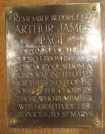 Arthur
James Page
Arthur
James Page
A polished brass plaque attached to the choir stalls, in the middle of the north side:
| REMEMBER BEFORE GOD ARTHUR JAMES PAGE ORGANIST OF THIS CHURCH FROM 1867-1904 IN MEMORY OF WHOM A FUND WAS INSTITUTED FOR THE BENEFIT OF THE BOYS OF THE CHOIR BY THOSE WHO REMEMBER WITH GRATITUDE HIS SERVICE TO ST MARYS |
Choir South
53Frank Radcliffe
A polished brass plaque attached to the south choir stalls directly opposite the (similar) one to Arthur James Page
| IN MEMORY OF FRANK RADCLIFFE MUS.DOC. ORGANIST OF THIS CHURCH 1914-1922 MUSICIAN AND PATRIOT WHOSE HIGH COURAGE SENT HIM TO THE WAR AND TRIUMPHED OVER ITS WOUNDS. THIS TABLET IS PLACED BY THOSE WHO MOURN HIS SUDDEN DEATH AT THE AGE OF 39 JUNE 28TH 1922 |
This monument is also listed as a War Memorial.
Tower Ringing Chamber
Floor Memorials
William Stretton, early 19th century Churchwarden and architect at St. Mary’s left records, including drawings, of items from his time that are no longer in place today. Until about the 15th century the most common memorial was a plain stone slab, bearing on its face a cross raised or incised, usually a ‘Calvary’ cross with steps at the base and its arms terminated in a trefoil or fleur-de-lys.
Stretton illustrated a large floor stone with a splendid decorative illustration of a 15th century merchant described as Richard Samon, Mayor and Alderman of the town who died in December 1457. It is possible that this stone, no longer visible, may be hidden beneath the wooden floor at present in the church.
 Stretton’s
19thC Stretton’s
19thCdrawing of the 1427 Samon slab |
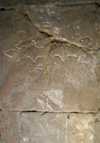 Modern photograph Modern photographof the upper part of the cross |
An older-style floor stone with an incised foliated cross and the arms of the Samon family belonging to Richard Samon who died in 1427 was recorded and fragments of this cross with identifying shield can still be seen at the west end of the church. This Richard Samon is believed to be the son of the first Richard.
Stretton also recorded and illustrated six other foliated crosses with stepped bases and sketched a number of other part or whole variations of similar crosses around the church. Unfortunately, it was not the custom to record the name of the person buried beneath these early crosses but clearly important citizens of the town were buried under this and the previous church. The stones bearing these crosses were later cut and used to top the ledge at the base of the north and south walls of the church where fragments of six different crosses can be still be seen.
An additional interesting early medieval slab, possibly a coffin lid, had a raised cross and was discovered in 1817 when digging near the communion rail for a vault for the Rev George Hutchinson, a Vicar of St Mary’s who died in October of that year. Its position was near the graves of Lady Brabazon and Hon Mrs Middleton. The work involved in producing a design in relief rather than engraved is considerable, so it would seem that this belonged both from its position and from its workmanship to an important person.
56John Whitlock
In the floor near the pulpit is a large slate stone dedicated to John Whitlock with the following inscription, translated from Latin:
The Reverend John Whitlock, also his son The Reverend John Whitlock. The former died on the day before 5th of December in the year of Our Lord 1708, aged 74. The latter died on the 16th of April 1723 aged 62
The Revd John Whitlock and the Revd William Reynolds acted as preachers during the Commonwealth period and listed in the church registers as:
John Whitlock and William Reynolds, Masters of Art of Emmanuel College in Cambridge were by the joint suffrage of the parishioners chosen to be ministers of this parish in April 1651.
In 1651 the pair were presented to St Mary’s by the Marquess of Dorchester and styled ‘Preaching Elders’. Whitlock took the place of the vicar and Reynolds became the lecturer, a title still used in St Mary’s.
57William Greaves
William Greaves’ memorial stone lies in front of the Samon tomb in the south transept, is in Latin and translates as follows:
Here is buried what was mortal of William Greaves, MA Secretary to the lord archdeacon of Nottingham Within the areas of jurisdiction of Nottingham and of the rural dean of Bingham Who was for a long time among the patricians of this most beautiful town, endowed soon after its origin with a royal charter, and, while he sustained and decorated very often the dignity of the Town Hall, so by guarding its municipal rights he greatly provided for the public good, not at all his own He died 30 May 1697, in the 77th year of his age.
On 7th February 1724 there was a disastrous fire at the office of the Town Clerk. The fire destroyed many valuable records but perhaps the greatest loss was that of the ‘Red Book’, known by the colour of its cover. This great book in which were recorded important matters relating to the town was lost.
However these important records were not irretrievably lost because two members of an important local family had retained copies of many of them. They are William Gregory’s ‘notes of the contents of the Red Book’ and the collection referred to as the ‘Greaves Papers’. The Greaves papers consist of 62 pages of foolscap, almost wholly in the hand writing of William Greaves. This man was the son of William Greaves, Rector of Nuthall, whose brother was Robert Greaves, Town Clerk 1617-1643 and 1652-1656. Robert had been deprived of his office on account of his connection with the Royalists at Newark. Robert and William Greaves were nephews of William Gregory.
William Greaves MA, the compiler of the above papers, was an Alderman of Nottingham and Registrar of the Archdeacon’s Court. He was elected Mayor in 1677 and occupied a prominent position in the resistance to the attempts of Charles II to obtain possession of the town Charters, which were, however, ‘surrendered through the treachery’ of the Mayor, Gervase Wild. For his opposition to these unconstitutional proceedings William Greaves was tried in the Court of Kings Bench 1684, before the infamous Chief Justice Jeffries, where twenty-two out of twenty-three were found guilty, fined, and bound to be of good behaviour for twelve months.
58On the pavement of the Lady Chapel is the following:
| Remember Norman Frederick Hooton White 1897 - 1982 Canon of Southwell |
There are also many floor slabs which are badly worn and not easily readable, and also twenty one brass floor memorials.
Burial Vaults
Several burial vaults were uncovered during work to replace the nave floor and install underfloor heating in 2012-3. The most interesting was the one to the Gawthern family for which there were two ledger slabs. There is metal plate with a crest and inscription at the top of one slab:
| Francis Gawthern, GENT, Died January 6th 1754, Aged lxx. |
Cut into the stone below the metal plate was the following inscription:
| Margaret wife of Francis Gawthern died Oct 11th 1753 aged 63 years Also Margaret daughter of the Above died May 23rd 1743. Francis Gawthern died July 7th 1841 aged 54 years Mary Frances his wife died Jany 12th 1830 aged 44 years. |
To the south of the above was another sandstone ledger slab with no vault beneath it but commemorating other members of the Gawthern family, including the diarist Abigail Gawthern. The inscription reads:
[In] Memory of |
The Gawthern grave slabs have been re-set in the floor near the west door. The vaults were capped and reinforced with a metal grill. In this section was a medieval cross-slab dating from the 12th-14th century, this is now displayed with a glass cover for viewing.
In the south-east section of the nave floor another vault with an arch section was found with several coffins. A plate on one reads:
| Charles Lomax Morley Died 7 March 1830 Aged 73 years |
He was a former Chamberlain, Sheriff, Alderman and four-times mayor. In this section was the known section of roll moulding upon which the present pillar sits. This now has a glass cover and is illuminated. Near the north-west tower pillar is another cross-slab upon which the tower rests. This also has a glass cover.
In the north transept the entrance to the Plumptre vault (c.1632) was exposed, which was blocked by ornate burial monuments (including a winged skull). A brick arched passageway was seen to be leading downwards.
Further information on the burial vaults and ledger stones is available in the Trent & Peak Archaeology report.


